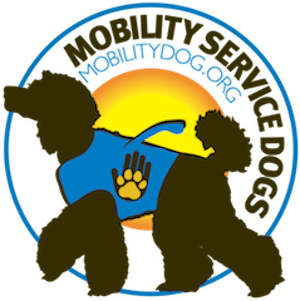Can My Dog Become A Service Dog?
Service dogs are noble animals, and it’s appealing to think you might transform your beloved Fido into a service super dog, capable of providing life-altering assistance to a person with a disability.
But hold on.
Service dogs aren’t ordinary pets – they are the “PhDs” of the dog world: Pups with High Discipline. Their personalities are special, their training is rigorous and the expectations for their behavior and performance are lofty.
The ADA: Requirements
The Americans with Disabilities Act (ADA) defines a service dog as one that has been trained to perform specific tasks on cue for a person with a disability.
Potential service dogs need 220 hours of special training to be recognized for its service role.
These PhD pooches may help with physical tasks, such as:
Courtesy: MobilityDog.org
Picking up objects; and
Turning lights on and off.
For some handlers, the dog may provide support with balance and bracing and also assist with standing and locomotion. This support is particularly important for people who use prosthetics or other assistive devices, such as wheelchairs.
Other service dogs alert to:
Changes in glucose levels.
The identification of dangerous scents (peanuts, for instance).
Specific sounds (including telephones, doorbells or smoke detectors).
Service dogs may also assist people with such non-physical disabilities including:
Depression.
Severe anxiety; and
PTSD.
Handling this wide range of responsibilities requires dogs that feel comfortable and can stay focused on their jobs despite an array of distractions. Going to the mall may seem routine to you, but the shouts of rowdy teenagers, the cacophony of seasonal muzak, the clanging of shopping carts and the opening and closing of carnivorous elevators would throw many dogs off their game. Service dogs can tolerate all this and still attend to the needs of their handlers. They meet this challenge because they are special hounds who get thorough and continuous training.
So what does service dog training look like for a puppy?
Service Dog Training: The First Eight Weeks
Like tiny humans, puppies have highly absorbent brains. They begin to learn from the day they are born, acquiring and processing information far faster than their older counterparts. That’s why yes, it’s easier to teach a new dog new tricks. Puppies approach novel experiences with curiosity rather than fear. Hence, the first few weeks are crucial for shaping a puppy into the confident, calm, courageous service animal the handler will need.
MobilityDog uses the Puppy Method to begin the training process for potential service dogs. Those responsible for initial puppy rearing (usually a select group of skilled and ethical breeders) expose them to the panoply of sights, sounds, smells and textures they will encounter as adult dogs. This exposure also includes the range of configurations in which humans present themselves: wearing uniforms, carrying backpacks, wearing hats, using crutches or a wheelchair and those who are friendly to dogs and those mortally fearful of them.
Service Dog Training: Eight to 16 Weeks
Courtesy: MobilityDog.org
Puppy raisers take over training at about eight weeks. They ratchet up the education to cover basic manners, including potty training (well-trained service dogs do their business on command, a trait many human parents wish they could instill in their offspring). They train the service dog in a set of behaviors that seem simple but in reality are challenging for many pups, especially those prone to distraction in a world full of enticing stimulations and possible threats. These behaviors include:
Responding to voice or hand signals for sitting, staying in place, lying down and walking near the handler.
Not soliciting attention from the people (or other animals) they encounter.
Not vocalizing (barking, whining or growling) unnecessarily.
Ignoring food, medicine, store merchandise or other interesting items they detect.
Remaining calm in spite of loud noises or disturbances.
Lying quietly beside the handler without blocking aisles and doorways.
During this period, dogs will also take many field trips to the kinds of places they will visit with their handlers. They may, for example, go to the airport and take their first flight. The goal is to give the pups some experience with every circumstance they will face with their ultimate handler.
Service Dog Training: 17 to 18 Months
After about a year and a half, the responsibility for training shifts to a dog trainer. This isn’t a cold introduction. The trainer will have associated with the dog from puppyhood. The trainer will typically spend between four to eight weeks with the canine, developing the particular skills required to meet the needs of an individual handler. This work will also incorporate input from an occupational therapist to ensure that the dog and handler properly bond and each understands the roles and requirements of the other.
Courtesy: MobilityDog.org
Should Your Dog Become a Service Dog?
There is no quick, easy way to produce a service dog, any more than there’s a fast track to getting your PhD in astrophysics. It takes a special dog raised competently from birth and given many hours of proper exposure and training.
So let’s admire these extraordinary beasts, while at the same time loving our personal pets whose main jobs are simpler, but no less important, to enrich our lives!




